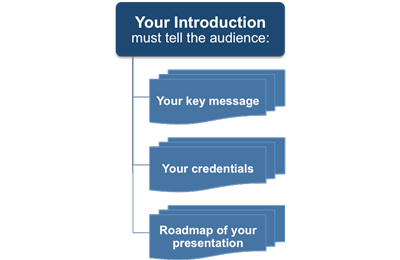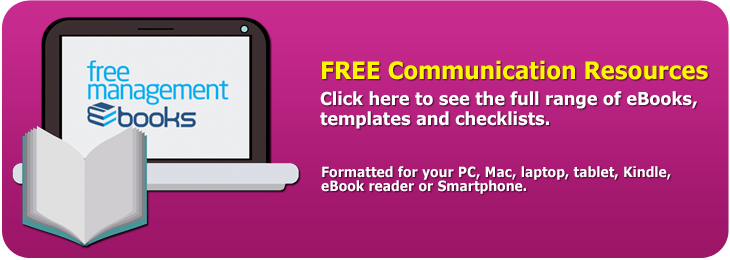Communication Skills - Preparing the Introduction
There are two big mistakes that you can make at the beginning of the presentation. The first is not being clear about your key message. The second mistake is not being clear about the structure of your presentation. To avoid this, your introduction needs to anticipate the following six questions from the audience:
1. What exactly is the point of the presentation?
2. Why should I care?
3. Who is the person making the presentation?
4. How long is it going to take?
5. What topics are they covering?
6. What order are they presenting them in?
Even if you feel that some members of the audience already know the answers to some of these questions, there is still a persuasive case for going through them. Ideally, by the time you've gone through the introduction everyone in the audience should know the answers.
If you are using visual aids then the first two slides that you present should inform the audience of your key message with your credentials and give them a road map showing the structure of your presentation. These must be visible long enough for the audience to take them on board.
Do not worry about the time this takes up. One minute spent telling the audience what your key message is and why you are there to deliver it will have a big influence on how much attention they pay and consequently what they take away. Becoming lost at the beginning of the presentation is very frustrating for people in the audience.
 |
An important function of your road map is to inform your audience whether or not your presentation format allows for questions. You may have to ask for questions to be kept to the end to ensure that you get through all your key points in your allotted time.
You need to make sure that everybody is on board with this from the very beginning. In some instances you may be able to note down questions as they arise on a flip chart and then answer them, if necessary, at the end. This is a useful technique because early questions can often be answered as your presentation progresses. Such questions allow you the opportunity to check for understanding as you go through them in your Q&A session.
The inclusion of your outline or road map in the introduction serves two purposes. Firstly, it gives your audience a clear expectation of how many topics you plan to cover. Secondly, the sequence of these topics illustrates the logic of how you will explain your key message and allows the audience to mentally prepare themselves to listen to those topics in the order described.
Outlining the topics in this way removes any uncertainty that members of the audience may feel about being overwhelmed or bored. Many people who have a high workload go to presentations with an inbuilt resentment because of the time being taken up. Anything that you can do to get the audience on your side from the very beginning is worth doing.
This idea of getting as many people on board at the beginning of the presentation will have implications for your key message statement. Ideally it should target the widest possible audience even though the importance of what you're presenting will be different for different audience segments.
Do not assume the audience already knows what the presentation is about simply from the title. Even though you may have been intimately involved with a new IT system or a new business process for many months and assume that everyone in the organization is familiar with it that may not be the case. One or two sentences are often all that is needed to make the point and context of the presentation clear.
There can also be an automatic assumption by some members of the audience that they need to share your background before they are going to understand your presentation. For example, if you work in finance you should make it clear that no specialist knowledge of finance is required if you are presenting to a non-specialist audience. By making this clear from the outset you can prevent a number of people from switching off.
One important point is not to give too much background information at this stage and cause the whole presentation to become bogged down before it starts. This will overwhelm the people who need the background information and will bore those who don't. All you need to do is make it clear that background information will be given as and when it is required, and that you do not need to be a specialist to understand what is about to be said.
The audience has no idea where the presentation is going unless you tell them. There is no table of contents and they cannot scan through chapter headings. Orientation is important because people like to know how much of a topic has been covered and how much further the presenter has to go.
Listening and understanding is hard work and asking someone to follow your arguments without giving them a clue as to exactly whereabouts they are can be very frustrating for them. People dislike not knowing how much content remains to be covered. This leads to anxiety as the audience members are continually asking themselves how much more mental effort is going to be required.
You may also be interested in:
Preparing a Management Presentation | Repetition and Timing | Your Presentation Aim | The Five-Stage Format | Preparing the Main Body | Key Point Guidelines | Finalizing the Main Body | Preparing Your Pre-Introduction | Preparing the Summary and Conclusion.



